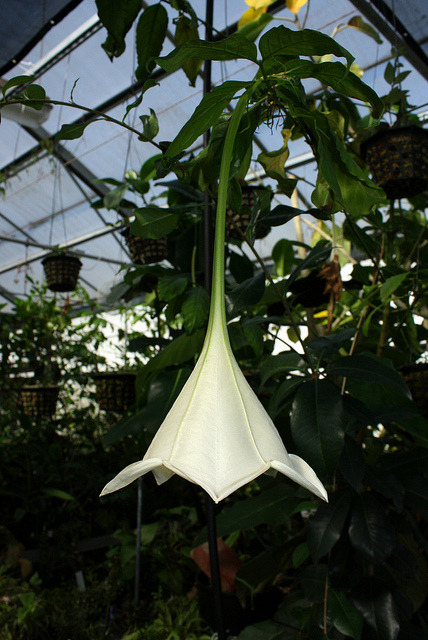Osa pulchra blooming at the Huntington Botanical Garden, San Marino, California. Osa pulchra is the
Osa pulchra blooming at the Huntington Botanical Garden, San Marino, California. Osa pulchra is the holy grail of showy tropical flowering plants and most of us have never heard of it. This spectacular member of the Rubiaceae is exceptionally rare, both in the wild and in cultivation. It is quite unusual that a flowering plant of such exuberant beauty can go virtually unknown for so long in cultivation. Its close relatives of better fame Portlandia grandiflora and Cubanola dominguensis, are familiar to some horticulturists in tropical climates. While in bloom this magnificent shrub may superficially resemble a coffee tree with white Brugmansia flowers hung from its branches, but surpasses both in elegance. The pendent trumpet-shaped fragrant white flowers are thick in texture and 22 cm in length. I have been working with a good friend, Dylan Hannon, Curator of the Rose Hills Foundation Conservatory for Botanical Science and Tropical Collections at the Huntington Botanical Gardens (San Marino, California) for the past 4 years to help insure this species’ survival ex situ within Hawai'i and in a few other suitable tropical countries. Until 2007, this endangered species was only known from two disjunct populations in the south of Costa Rica, one on the Atlantic side and the other on the Pacific side in wet lowland rainforest. Less than 30 individuals exist between these two populations in which natural reproduction is very poor. In addition, because of the location and nature of both colonies, botanists have been hesitant to accept that these plants weren’t planted by humans at some point due to their proximity to human dwellings¹. Five years ago Osa pulchra was found for the first time in Bocas del Toro, Panama. University of Panama biologists Reyes Carranza and Fermín Hernández found this species during an environmental impact survey² . This exciting discovery may be the first record of a wild population. Nearly all plants in cultivation outside Mesoamerica trace back to seven seedlings resulting from a pod collected in 1996 on a Missouri Botanical Garden expedition to the Osa Peninsula. About 100 F1 seedlings were raised at the Huntington and distributed to select conservatories in mainland USA in 2006¹. Notably showy specimens can currently be seen at the New York Botanical Garden, the Atlanta Botanical Garden and the Huntington. Propagation of Osa pulchra is not for the impatient horticulturist. Growing from seed is the preferred method. Asexual propagation is possible but it exacts a sacrifice of the terminal stem. As with Portlandia, Osa have exhibited stubborn apical dominance, sometimes referred to as the ‘conifer effect’. Hand pollination must be carried out between two different clones because individual flowers are infertile. Gestation will take up to 11 months, upon which seeds must be sown with haste due to their limited window of viability. ¹ Hannon, DP. (2007). Osa pulchra: fragrant trumpet flowers from central america. Tropical Flowering Tree Society Quarterly, (Winter), 9-11. ² Aiello, A, Correa, M, Galdames, C, Alvarado, M, & Calderon, ML. (2007, August 31). Remarkable new plant record for panama. STRI News, Retrieved from striweb.si.edu/strinews/PDFs/August_31_2007.pdf © Uluwehi Knecht (text) © Dylan Hannon (text) -- source link
Tumblr Blog : phyto-porno.tumblr.com
#rubiaceae#pulchra#endangered#species#flower#fragrant#costa rica#panama#rainforest#pendent#trumpet#coffee#gardenia
